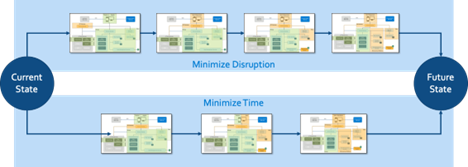As companies struggle to keep pace with the pace of change across industries, many are looking to transform their existing applications and infrastructure assets to meet these challenges. Often referred to as “modernization” initiatives, these efforts can target a wide range of goals from supporting new business opportunities, taking advantage of emerging technology capabilities, automating manual business processes, meeting the increasing needs around security and compliance, as well as stabilizing solutions to improve supportability, performance, and scalability.
As we work with our customers to drive these modernization initiatives, we find that it is critical to ensure that they take into consideration all aspects of modernization: Technology, Architecture, and Process.
Technology Modernization
When most organizations think of modernization, this is typically the first aspect that comes to mind. They’re concerned about end-of-life technical platforms that have been in the environment for years and are starting to have a negative impact on the systems they support. They may no longer be patched to meet emerging security threats or may be driving up vendor maintenance costs (if they have support available at all). Whatever the reasons, there are definitely issues that should be addressed to ensure that these systems continue to support the business as needed.
However, simply replacing old technologies with new ones does not mean you’ve modernized your systems. Yes, you may have addressed some of the immediate IT issues around security, patching, and overall support. But putting new technology versions onto an old design does not result in a modern system any more than putting new tires on an old car makes it a new car. The business benefits of such initiatives are short-term in nature, limited in impact, and typically do not help enable the organization to meet the current and future business challenges.
Architecture Modernization
What is needed is a modernization not just of what technologies are used to build the system, but of the underlying design of how those components are combined. This is why we view architecture modernization as the most critical part of any modernization initiative. A more modern architecture using loosely coupled components that operate with more independence, built on best-fit off-the-shelf platforms as appropriate, will deliver a more meaningful return on any investments into system modernization.
Such architecture modernization offers several key benefits:
- Reestablishing the system design to better align with the business needs of the organization, increasing the ability to gain business value from these systems
- Enabling the organization to better leverage new and emerging technologies that can transform the way the company performs day-to-day business processes
- Easing change management by minimizing technical dependencies
- Allowing for more efficient delivery models that can drive increased agility and speed to value
- Positioning the system(s) to allow for future modernization with lower levels of cost, risk, and impacts of change.
Often, such architecture transformations can seem difficult to tackle due to the perceived risk and cost inherent in such initiatives. When looking only at the current and end-state designs, the amount of change can indeed be daunting. But, as discussed in the previous section, just upgrading the technology versions will not meet the true business needs of modernization.
The key is to chart an overall roadmap that defines the appropriate transition states along the way – such transformations should never take a “big bang” approach. By breaking up the transformation into more manageable “chunks” of modernization, an appropriate modernization strategy can be determined by laying out the interim technical designs and having open business conversations about the tradeoffs (i.e. cost vs time vs business disruption).
Figure 1 shows one exam

Another key concern for organizations looking to implement such modernization initiatives is the ability to maintain and mature the new system(s) once complete. This leads us to the last of the key aspects of true modernization: process.
Process Modernization
Conway’s law is an adage that states (loosely) that any organization that designs a system will produce a design whose structure is a copy of the organization’s structure. In a broader sense, what this means is that how you go about modernizing a system will have a direct impact on what you get in the end. Creating modern systems requires taking a more modern approach to how you manage, scope, design, code, release, and secure these initiatives.
For this reason, we feel that implementing modern software development and platform engineering processes is critical to the building and ongoing management of modern IT systems. The need is for a continuous, iterative process that leverages the appropriate tools and automation that allows an organization to leverage technology to innovate and create business value faster, efficiently, and more securely (see Figure 2).

Figure 2 – DevSecOps
At Forty8Fifty Labs, we bring these best practices to each of our engagements and work with our clients to integrate them into their organization, as appropriate. Using this approach, we can ensure a successful outcome of not only the implementation but also the continued value generation of the new modernized system.
Our Modernization Services
We believe that legacy applications can impair customer experience and reduce operational efficiency. Our strategy-led approach will help you build and execute an intelligent roadmap for accelerating and de-risking your modernization initiatives. Learn more about our application modernization services here.
Related Posts:
4 Common Mistakes When Moving Your ITSM Solution to Atlassian’s Jira Service Management







